Carlos Santana, Prodigy, Grand Master Flash. Whitesnake and Jellybean Benitez. What’s the connection?The band Babe Ruth. ♩ ‘Chico Fernandes, Sleepin’ on his gun’… ♪ I’m honoured to have been able to conduct this interview for fans, DJs and music lovers everywhere as it is very personal to me meeting with a group that contributed to such a joyful time in my childhood. In fact, the whole thing turned out to be more of an insightful and flowing discussion with lots of laughs and a journey down memory lane really, making sense of musical things that at the time I was too young to understand. After listening to over two hours of raw audio, time constraints forced us to edit down some of the gems we received. That, coupled with the compromised audio (my fault) made it a task to expeditiously deliver these wise and inspiring words, but luckily, in no way did this affect the essence of our interview with the legends. We hope you enjoy.
–––––––––––––––––––––––––––––––––––––––––––
Janita Haan is the lead singer in the band. Along with David Punshon Keyboardist, the two of them make up a significant portion of Babe Ruth. Both of them co-wrote and/or performed major parts in the composition of a host of great songs they released including the classic of 1972 ‘The Mexican’. Not that it’s all about The Mexican but that song, in particular, is a very important part of the band’s identity. If you’re not familiar with the cultural reach of the genre fluid masterpiece, it’s high time you explored it further as it is a cultural study in and of itself. Me: the song pierced my soul through a window called Hip Hop, for some it may have been Rock, Latin or maybe even a house mix. Yet the unintended world B Boy anthem was recorded here on UK soil, which makes it even more fascinating and dissident in its form, much in accord with the band itself-Babe Ruth.
I∞∞∞∞∞∞∞∞∞∞∞∞∞∞∞∞∞∞∞∞∞∞∞∞∞∞∞∞∞∞∞∞∞∞∞∞∞∞∞∞∞∞∞∞∞∞∞∞∞I

I∞∞∞∞∞∞∞∞∞∞∞∞∞∞∞∞∞∞∞∞∞∞∞∞∞∞∞∞∞∞∞∞∞∞∞∞∞∞∞∞∞∞∞∞∞∞∞∞∞I
AL: So where are you from?
Janita Haan: I‘m from England but my formative years were in California.
AL: Do you think that had a lot of influence on your music?
Janita Haan: Oh yeah. I mean for me it was. I think I’d just finished high school but I wanted to sing, really wanted to sing, and around that time I was in the Bay area around Santana, Janis Joplin, Miles Davis, Sly And The Family Stone, Jefferson Airplane. It was lovely, it was just fantastic, musically for me, you’d get the feel of Candlestick Park, I used to bunk off school and go down with a frisbee to the park. It was a magical time, especially when I came back to England the third Santana album had just come out, so all I had with me when I came back was the album to make me break my way through, (laughs) I didn’t know anybody.So I had to start from right at the bottom to make connections, I was only 18, it was pretty scary for me.
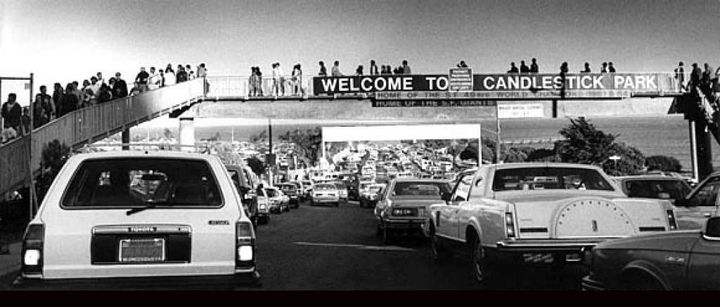
Candlestick Park - San Francisco
AL: Was there a level of Intrigue about you coming from America to England? People are normally fascinated with someone being from somewhere else. Were you the American girl?
Janita Haan: Well, I suppose with California because I was a California hippy. At that point, I was back with my English family and that freaked them out cos I was just this wild child. They kicked me out after a bit so I had to find my own way, that was a bit scary but I knew I wanted to sing. I came across some lovely people along the way. Once I came across this little studio I can’t remember where it was but they would allow me to come after sessions at night because I had to work to earn some money to pay my rent, but I hadn’t much left after that (laughs) I had about two quid to get food and everything which wasn’t much.Back in the day, the tubes were not like they are now, you could hop on and off. So this little studio place would let me go in after hours and practice with their mics, then I got enough confidence to answer ads in the Melody Maker. It was very scary I hadn’t been in a band before then. I answered an ad for a Band called March Hare, I nearly got the gig for that. I didn’t quite get it and the next one after that was for Shack lock… Babe Ruth used to be called Shack Lock. Dave Hewitt answered the phone and said ‘What are you like’? and I said I’m 5ft and I play the congas (laughs). Cos I hitched up and down California and one time I was out there with these Hells Angels and they had me play congas. So they came to… where did you come to, Finch House was it?

Dave Punshon: I think so, we turned up and all I remember is your tea set it was like really, really Mary Poppins, all quaint China and I thought ‘Wow! That’s ornate’.
Janita Haan: (laughs) I think it was my Grandmother’s.
AL: And this was in Edgware?
Janita Haan: Finchley, I had a bed sit there. They came that Saturday and Alan had this acoustic guitar and so he’d be playing and I’d be singing because I think he wanted to test my ear to see how I was. Anyway, they invited me down to the audition at Manchester Square and there were forty blokes and me. It was between me and that sweaty singer, sweaty Nelly was it? (laughs)
Dave Punshon: From New York.
Janita Haan: Yeah. The band joke is that because the wage was so paltry (laughs), it was hardly anything, they said that ‘We’ll have Jan’ and the band rehearsed me so hard. Unbeknown to me EMI were kicking up because they didn’t want a singer. The boys protected me, they kept it very quiet and rehearsed me really hard and then Nick Mobbs – who signed the Sex Pistols – came down to a showcase and I was on the showcase, lucky for me he liked it and within two weeks we were in Abbey Road recording the first album: First Base. It’s amazing how everything turns on a dime, everything can turn on a dime.
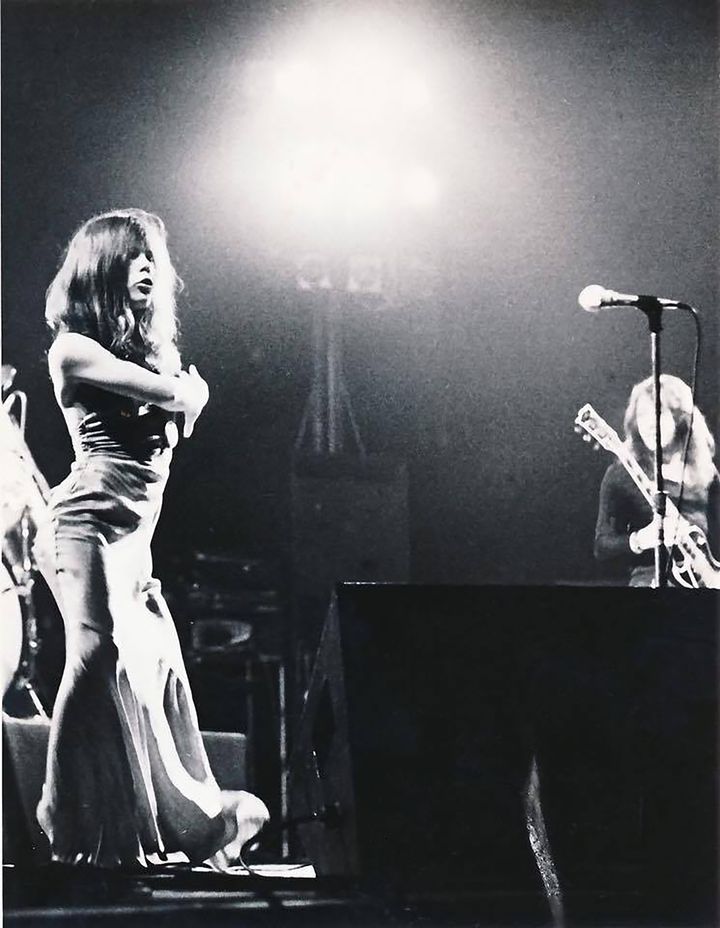
Janita Haan / Babe Ruth live
AL: You guys obviously have some chemistry. The recordings that I’ve done myself personally, I know you have to protect the studio environment. Do you feel if the vibe isn’t right it comes out in the music? Dave Punshon: Yeah, I think we were all excited about recording at Abbey Road. And also we had a good engineer: Tony Clark. Janita: Does that answer that then?
AL: Yes quite a few questions actually. When was the first time you knew you could sing?
Janita Haan: I was a bit of a dark horse actually because my family had a house in Fairfield, when they’d gone out I’d start singing, I had an imaginary life. I’d sing all the songs, I’d sing out loud and that’s when I first started wanting to just like play, act, sing, dance and do all that stuff, at the cemetery as well but I’m not sure at all if they could hear me. (laughs)
Dave Punshon: Cemetery?
Janita Haan: Yeah, there was a cemetery at the back of the house and fields as well.
AL: What bands were on top as you hit the scene as Babe Ruth?
Janita Haan: The Who, Rolling Stones, this is over here: Grand Funk Railroad, Creedence Clearwater, Steppenwolf, when I grew up. I was doing art in high school I was into Joplin, Hendrix…
AL: Yes you’ve been compared to Joplin haven’t you? That’s what I thought actually.
Janita Haan: Yes that’s right. I think it’s the wild energy. I was a wild child, I’ll always be a wild child really. I think being brought up in that area, and Dave and I really connected on this as well, it’s that you have a real solid belief in living who you really want to be and people try to indoctrinate you into categories and that’s where I rebel. Yes I can understand when people say she sounds like that and sounds just like that and that was cool but when they try to dictate what you can and cannot do, and that’s the California philosophy, I think… because they always say ‘You can be what you wanna be, you can do anything you want as long as you believe in it’, I truly believe you can be what you want as long as you have the strength and the determination to do it. I had nothing and I just knew what I wanted to do I was real focused and really lucky. I was very fortunate. I moved to San Francisco just because my parents were trying to get me to England for six months to straighten out, I was, at that time, hanging out with a bunch of Jazzers and I ran into Tony Williams who became my mentor and he imparted on me such a wonderful knowledge of life, of music and he wanted me to go back to New York but my ticket was already booked, so that was my journey. I came back to England and I was very fortunate indeed to become the lead singer of Babe Ruth.
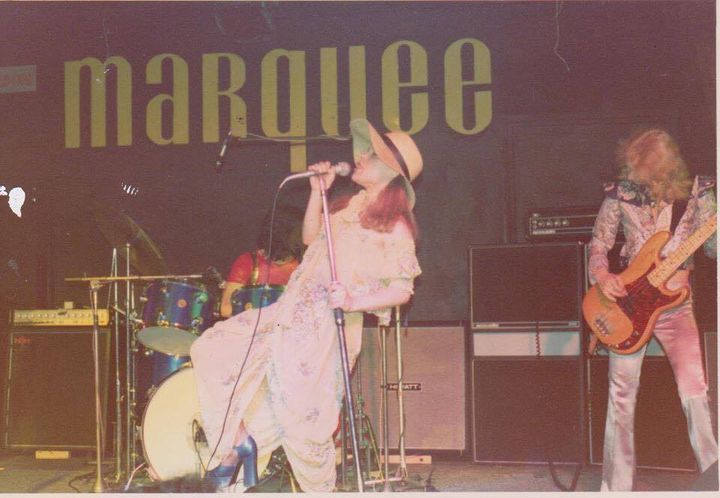
Babe Ruth live at The Marquee (Wardour Street)
Dave Punchon… Well, we were the fortunate ones, thank God we didn’t get sweaty, whatever her name was. Janita Haan: I mean it was like I had this wonderful Jazz thing and then had all the classical training from the guys because Alan studied at the Royal Academy Of Music in Spanish guitar and Dave was also classically trained, Jazz trained and so there’s this element of discipline that moulded me and gave me that structure in everything that I’ve done since then and that’s been enormous and also because of that mindset I discovered that we never allowed ourselves personally, when we worked with music it was always about the music…
Dave Punshon: …It was called being professional actually.
Janita Haan: …Yeah, yeah I’ve worked it out, people that actually start taking things too personally instead of being able to say ‘Well actually yeah let’s try that, I do agree with you maybe, we should try this or let’s do this’, instead of this immediately taking it personally. I’m like Woah! whats this, you know?
AL: Yeah when you get those goose pimples and if you don’t get that a lot of the time it was made here in the mind.
Janita Haan: Yes, also we were never allowed to take ourselves very seriously and believe the press. So that was great too because all of a sudden you realise that you can’t start believing your own press.
AL: You know Crazy Legs and you went to the B Boy conventions?
Dave Punshon: Yeah we know Crazy Legs. We headlined the 2002 B Boy Championships in Brixton and he was there as an MC, as a judge and so that’s how we got to meet him.
AL: That’s incredible to keep music in that way that it all comes back together. It’s the love of the art.
Dave: It was a wonderful thing for us to be associated with the B Boy scene, knowing that people like Crazy Legs are so community orientated. He’s still the same – Crazy Legs, he was standing there on stage before he gave out all the free stuff. He was saying ‘ Is there anybody here that works with the community’? That’s what he said and a lot of people put their hands up, I think he’s influenced a lot of people to help younger kids gto get into something constructive because they did. There’s that picture of the Rocksteady Crew as little kids, eleven-year-olds putting all their weapons on the table in the New York police station. Like zip guns, flick knives and machetes. They were like ‘Why are you carrying this’ and they said its protection against the big gangs. And they got the whole B Boy thing together to get the gangs off the streets, which is fantastic so I’ve got a lot of time and admiration for somebody like Crazy Legs, to be honest.

Crazy Legs
AL: How did the American public and other musicians in America accept you guys when you arrived as Babe Ruth? Dave: Well, you’ll be able to talk about that because I’d left before the American tour.
Janita: Yeah Dave had left, unfortunately. We played with big bands, we played with Aerosmith, The Doobie Brothers, The Beach Boys…Roxy Music supported us, that was really weird they’re so huge over here, they liked us, I think Milwaukee loved us, Canada Luuved us, they still love us which is lovely. I think it was a different court because we had a lot of personnel problems, Dave left, we changed drummers and Alan was never, although he might not admit it, he wasn’t one for touring, by that time he was getting very interested in producing and then there was a lot of internal politics going on. We had a lot of problems with management, the same old thing being ripped off, record companies. After the third album, I think Alan left and we got Bernie Marsden from Whitesnake before he joined Whitesnake so he came. It’s difficult because we had to cut out a few of the songs because, they couldn’t play it basically. The Mexican just for starters.The whole thing for me, for Babe Ruth and me, we’re very much a family. Babe Ruth is a family and always will be a family. Me, Dave, Dave Hewitt, Alan and Ed now has been with us a long time but Dick is still a very big part of it. I still feel an incredible sadness of Dick leaving because I think, what we were talking about vibes and everything, there’s something about a synergy of people, Isn’t it Dave?
Dave: Yeah.
Janita: When it was Dick, Alan, Dave, Dave and myself there was a synergy that created Babe Ruth, it’s interesting to note that it was the first album that had created all this magic for us over the decades. We just laughed, it was just a fun time and I was so young, all of them were like my body guards, it still is all like that. I mean Ed’s become very much part of, and is, Babe Ruth and is a wonderful man and has a crazy, crazy latin sound which we love and of course the sound that we recognise, there’s that western theme and obviously the Mexican Spanish things that are very close to our hearts the 3rds, that was the initial sound that Dave and Alan produced which was those 3rd runs. Dave, you’ve got an anecdote about The Mexican, come on.
Dave: Oh yeah, when I first joined the band we all met at Alan’s parent’s place, there was a piano there, all the guitars and everything and he just handed me sheet music with all the parts written down on it. He said ‘This is called The Mexican, it’s all about Chico’ and I said ‘Yeah’ and I looked at it and I thought that’s a really weird song, I mean really unusual, I hadn’t seen anything like it and he said ‘Yeah so shall we play it then’ and he wanted me to sight read it which at that time I was into and so we played and I thought this isn’t like a Pop song at all or like a Rock song it’s completely different and of course never guessing that it would get where it got to at that time but everything was written out, everything.
Typical below is an example of the Mexican Effect.https://www.youtube.com/watch?v=EtFuwqMfn-k
Janita: Funnily enough, cos when I started learning The Mexican, I got it on a sheet, I’m still looking for it, I have the original sheet of paper somewhere which I wrote the lyrics on…
Dave: … What the Mexican? Did you?
Jan: Yeah I was trying to find it, I think it would really be lovely to see that. I can’t find it anywhere. I remember being at Pete Fordham’s place learning it. I’m sure that was the first, first song I learned. It wasn’t Wells Fargo it was ‘The Mexican’.
Dave: It was The Joker as well, yeah I mean Alan is such an innovator, well was then you know. The Joker had two different rhythms (a small humming example joined in by Jan) on the bass and drums then you got the guitar and piano playing in 3rds (Dave hums the guitar and piano) and if you do the… (Dave invites Janita to sing the vocal)
Janita: (Singing) “I said, Hey cat you gotta move outa here, I got enough to turn you on”
Dave: Yeah, and it was like such a minimal thing that it introduced me to the concept of funk. You know how there could be such a funky thing going with just two simple rhythms opposing each other.
J: And of course when we started rehearsing because I’d just come back from Cali and I’d been in Berkely, San Francisco around Sly, the whole funky thing so we could jam and funk and I loved it. I didn’t realise until someone said that that the rhythms were quite funky, especially in the first album and the second album.
D: Alan was highly influenced by Motown. I mean really highly influenced by black music and all the players like Bernard Purdy on the drums… (Dave gives a beatbox example of the cymbals as Janita joins in with her version, laughing). … With the cymbal work and everything to the extent that he actually told Dick what to play so it was very arranged: the whole thing and it needed to be in order for it to work rather than everybody just jamming their idea of what funk was.
J: I mean we rehearsed very, very tightly. Sometimes we’d say ‘right come on two bars, back, bang, that’s not right, second bar there.
D: Seven hours a day, rehearsal seven hours with a lunch break.
AL: Pre signed or…
J: Post signed because I was with you.
D: And pre signed as well, absolutely.
J: Because in the initial days they did their own version of the Narciso Yepes, Rodrigo Guitar Concerto.
D: That was her first gig ever, that was in Huddersfield at The Builders Club.
J: Of course then, me coming from California where I’m with the Mexican influence there it just completely created this I suppose, which we didn’t realise at the time, but yeah decades later you think yeah that’s what it was (laugh).
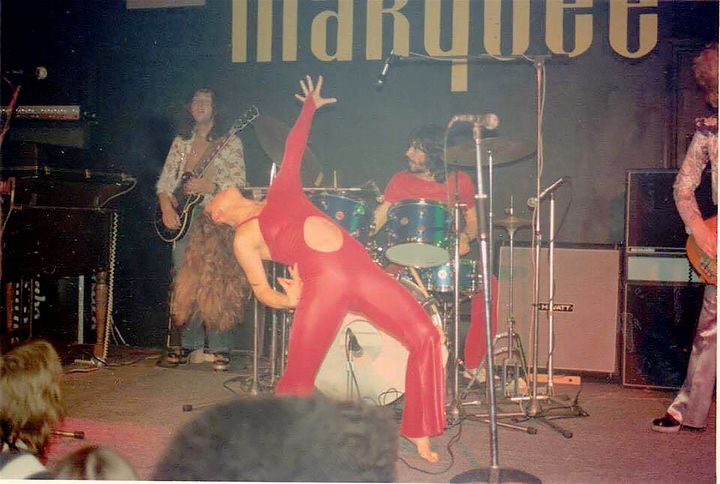
Wilding on stage Babe Ruth
AL: It was a genius song and it was a beautiful combination, you can see every part is being played in that song and it just fits and it was so authentic. I thought ‘Who’s this Spanish chic singing’? Then to come to find out that you guys are from the UK.
J: Hatfield (laughs)
AL: At the same time the influence, it was a really good collaboration.
J: I think certainly Dave and Al’s influence on the sound, those 3rds were significant.
D: And of course the influence of Wishbone Ash, because you know they had two guitars playing in 3rds. That was their signature thing and I think Al was influenced and he thought why not have that piano and guitar doing that in 3rds, so it’s like… (Dave gives another mouthed example of the guitar) … all in 3rds you know and that was like the signature sound of Babe Ruth then.
AL: What was the vibe in the studio when you actually recorded it.
D: Well, we’d been playing it for weeks on the road so it was like so well rehearsed. We were gigging. we just went into the studio and laid it down.
J: It was interesting because I always sing with everybody to start with and I think that’s what? That little bit of magic, because I’d sing full out with everybody in the back, then when you’ve got the basis of it, you put it all out and start again adding to the feel of it, then at the end, I’d re-lay the vocal on top.
D: That’s right I think the whole concept was, I remember Al talking about it with us, he said ‘ We just wanna go in there and play it with what we’ve got as if we’re doing it live on stage’. Mainly on First Base. Then he added organs and like brass and strings and things.
J: I remember being in Abbey Road. They would syphon off, they would put things in front of me so there would be no musical spillage from different instrumentation, separation booths so that when we took them all out again we were left with drums for the bass drum feel but the drum would be playing with rest of the band so it was a live feel. So from that, the additions came.
AL: All arranged by Alan?
D: Yeah. He did actually. I mean Dick was basically a Deep Purple type drummer he was into all that where there was like lot’s of drums going on all the time. I think Alan wanted this sort of Sly and The Family Stone type approach which these days they call it Opportunistic Composition which means that where there’s a space another instrument that’s not playing takes it. So you get something like the bass and drums will play like on a grid they would play a certain pattern within grid and the spaces that were left were taken up by the guitar and keyboard and that was what made Sly And The Family Stone, so it was like an intricate jigsaw of the instruments playing together, and that’s what Alan wanted, so when Ed came into the band he laid it down.
J: He was so percussive, Latin percussive.
D: You get something like Dr Love or Gimme Some Leg it’s just like laying it where it counts. Without any fills unless they’re needed.
J: Al was always one to take me out of my comfort zone. Dave remembers me being in tears on our first album. He hated dot players. Dot players are people that put the scores and arrangements in front of them and if you take them away from them they can’t improvise. D: Although he did use dots, but it wasn’t just that.
AL: What do you think about Keep Your Distance? That was another, not a B Boy classic but pretty big for Hip Hop Dj’s.
J: Bernie, Bernie Marsden. There was ‘Elusive’ that Ed wrote and of course became a disco hit in New York Jellybean Benitez also rang me. I’d just finished doing my degree in fashion and he rang and asked me if I wanted to sing, he was doing a remake of The Mexican when he was first with Madonna. I said yeah! so he flew me out to New York and then I did that and then that became a number one in the Billboard Charts. He did a great version with lots of latin beats and percussive beats mixed with percussive beats.
AL: That did well on the hip hop circuit, I think Africa Islam and a lot of New Dj’s used it too.
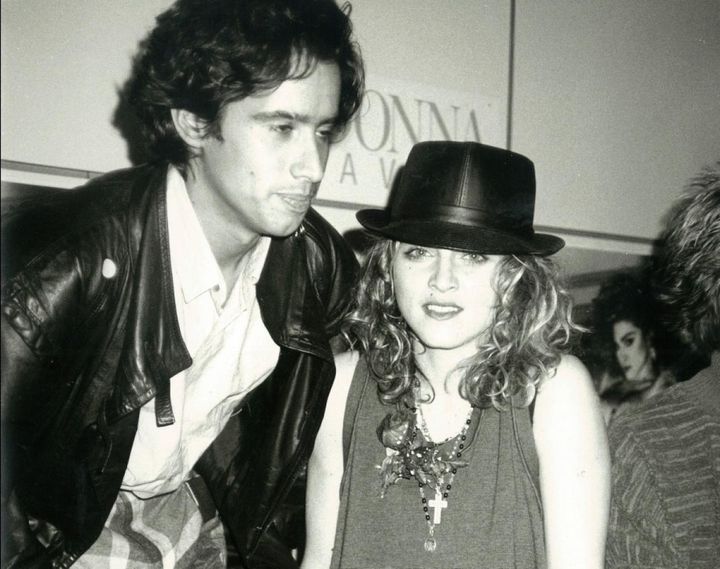
John ‘Jellybean’ Benitez with artist friend
J: It was huge on the circuit. I think Prodigy used it.
D: Actually Prodigy used the Babe Ruth version. GrandMaster Flash used it and for years we didn’t know that there was love for this song. Yeah it was like a parallel universe. there’s a story to this. Al was in London, because he was living in the states at the time and he was over with his son and they were walking around Carnaby Street and they heard it in a shop and there was a Dj in the shop. He went up to him and he said ‘That’s our song’ and he said ‘No it’s Grand Master Flash’, he said ‘No, well I wrote it’. He said ‘Well it’s got here Grand Master Flash’. So Al got a little upset. This was around 2001, it was because he phoned and he talked with Grand Master Flash and Flash was absolutely like ‘ Oh my God this is terrible’. And he traced it back to the white label days in the early 70’s where Dj’s would have white labels so the other DJ’s couldn’t see what they were playing. So it was part of his culture and he was mortified so he said ‘Look you must come on tour with us, we’ll put the band together’. What he did was, he introduced us to DJ. Hooch who runs the B.Boy champs.
J: It was lovely because he said his all-time favourite song was The Mexican. Which was a real honour for us and he’s become good friends with the band, matter of fact he wanted us to come down this year. You went, didn’t you?
D: I went, yeah. It wasn’t the world champs it was the regional one, but it was real fun, at the 02 Centre in Kentish Town.
AL: I want to talk about your energy on stage, it was there, hair flying, there was such a confidence there.
J: I am. On stage, I’m very confident. People always say she’s so shy. It’s my alter ego, I’ll put myself out there I’ll do it. oh, I love it. Again going back to the Bay Area, free concerts, them days, do as you like, freedom. Express yourself and I was always into dance. I was curious and fascinated by it, what was going on and this then goes back to the lack of a family, finding your way because the family unit, during that period I think on a lot of levels, affected a lot of people for the lack of a family I would say.
AL: I feel there was a gap between the 70’s and now where people were very materialistic and now it’s coming back down to authenticity, it seems to be resurfacing.
J: Do you think that’s down to the onslaught of free downloads that’s killed so many musicians. It’s devalued that we can spend hours and hours recording something that means a great deal to us, we don’t get paid for it and the listeners get it for free. So all of a sudden if you look everywhere now even with the agencies, they don’t rely solely on sales. They can’t because it’s impossible so they have all the groundings. So then we get into all the groundings. The image conscious society that we’re in. And that’s fine and that’s very interesting, then all of a sudden the emphasis is on how do you look? What’s the dance routine? What is the makeup? Are you gonna brand that? Are you gonna sell that? How many likes do you have on Facebook? And we all play, we have to play it.

Janita Haan upside down mid-performance
AL: Extremes always come out on the other side. It’s like thank God for Donald Trump in a way. It makes people think what kind of world are we living in. That can only be a good thing. Authenticity is creeping in. Some of the Old Hip Hop artists are coming back after twenty years and they’re doing quality music. How do you feel about?
J: The good thing again is that there is less of the ageism and less of the sexism today. Especially from a female point of view because of course when I started there were very, very few female Rock singers… female singers period in the music industry in the United Kingdom anyway. And now today it’s a whole melting pot of different singers. In some ways it’s good and some ways it’s bad because sometimes I think that what we are losing is the whole ability to actually learn a craft and pay your dues. You press a few buttons, you get a beat, of course, it’s fine but if you take that away from them, can they play? No.
AL: Unfortunately I’ve had to lean on some of that.
J: And that’s absolutely fine, I just feel you must remember to learn instruments as well. Because that’s when the feeling comes in.I was listening to Sarasate, violinist, back in the day and the feeling. Ohh! And that goes back again to the development of the digital age, where back in the day it was analogue and the reason why analogue was so warm on the ear was because it’s natural. It’s on a curve, but digital is like that (Jan uses hand movements expressing up and down motion) That’s why it sounds great but it’s very clean and clinical with no emotion and you find now that I suppose people are going back to using vinyl. Although a lot of people are now putting vinyl out and cassettes (laughs).
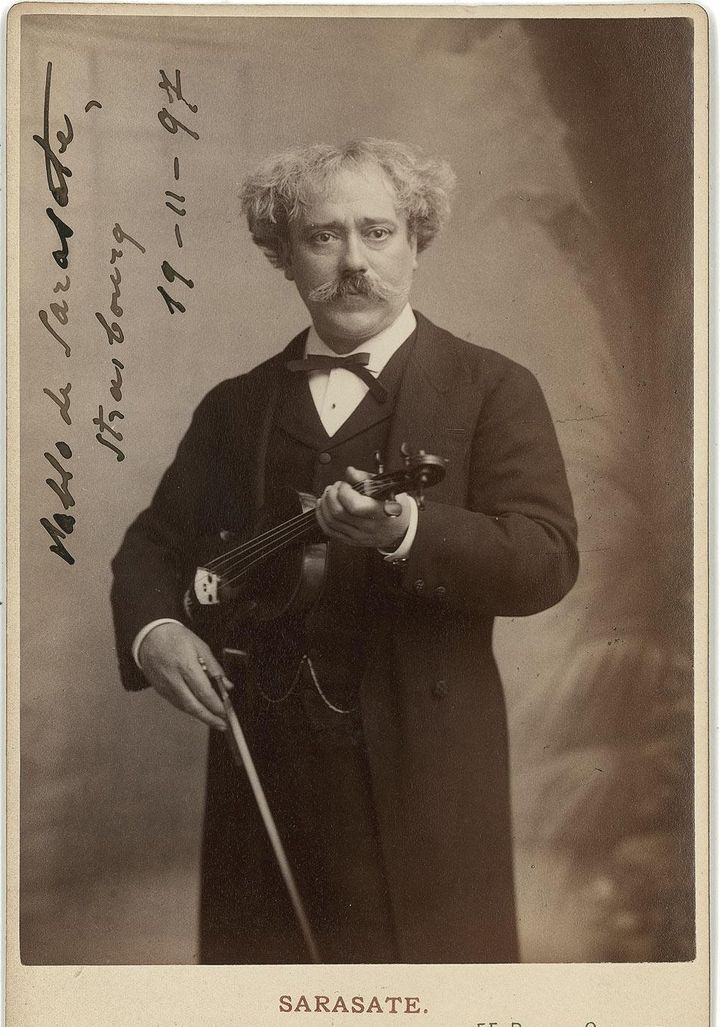
Violinist – Pablo de Sarasate
AL: You performed a Curtis Mayfield Track in Montreal in 1975- Darker Than Blue. As it was introduced someone in the crowd said ‘About time’. I found it funny.
J: Because of my being in the ghettos and my association with the Hispanics and the underdog thing, for me, it was very significant, it’s just one of my favourite songs to sing, that and Black Dog. They’re just great songs, good writers. I stand very closely to Curtis Mayfield as a favourite because even with classical music you can have three different singers all singing the same tune and sing it absolutely notationally correct but because of the thumbprint of a time worked voice it doesn’t sound the same. So I approached ‘We People’ in exactly the same way. https://www.youtube.com/watch?v=UyPKee16zdY
AL: I have to ask about your physical form. On stage you were fit. Six pack and everything.
J: I didn’t do any gym. That’s from singing in overdrive for long periods of time. When I did a performance sometimes I’d lose five pounds. Just the sheer energy and also I can’t eat when I sing. So I wouldn’t eat, like today I haven’t eaten because I was singing. If I eat it’s gonna sit heavy on my stomach and then the heaviness becomes the spirit and so then the song will create that heaviness of spirit that I do not want. I want the lightness of being and I also then have the ability to concentrate on the music and the lyrics and the voice to get the best I can possibly get out of my voice and learn something along the way. The six pack came surely from that. Literally singing Black Dog, Wells Fargo, Gimme Some Leg, running around a lot. But mostly it’s because when you sing there are four levels of singing: there’s neutral, metal, overdrive and belting and most of the time I was singing in overdrive or belting. You have to use these core muscles to really… and the boys were loud (laughs) I was battling all the time to get my voice over. So I’m singing full out.
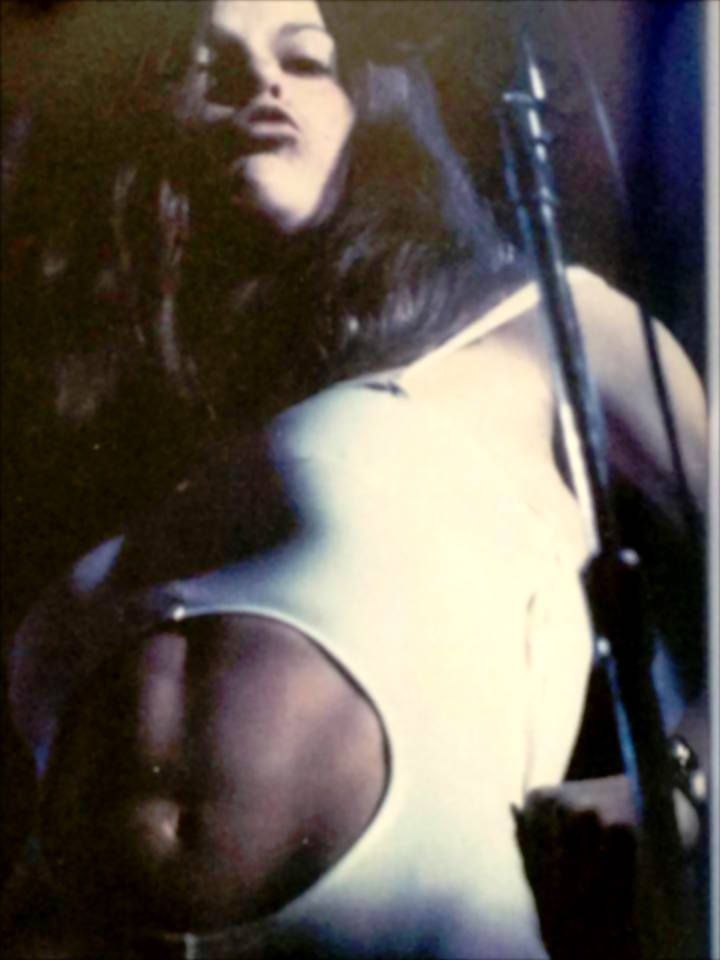
Steel abs. Janita Haan on stage
AL: Is there anything, any wisdom that you may know exclusively that you may want to share? What song do people need to listen to?
J: Well for me it’s anything to do with bringing people together. I’m not good at violence, I hate violence, when people are nasty to each other it upsets me very, very deeply. I’m very reclusive by nature. I suppose it’s Let’s Get Together by Al Green.
D: Something just came to mind, I talked with my writing partner about this. We were talking about the levels of professionalism in bands. Where they don’t think about what they’re each individually playing and they’re getting rid of their individual ego and what happens is it’s almost like a common spirit works through the band and very often a lyric comes with it. I’m thinking of particularly Jazz players like Chick Corea, his band and anything at that level but I honestly believe that… you know how you talked about the ethos of the 70’s is coming back now …I honestly believe that it’s coming through and it’s gonna be such a thing that you’re gonna get groups of people standing on the stage and it’s gonna be like one being, playing. I honestly do I think that’s the next stage because of the way the world is. A lot of the people that came in especially in the 50’s whatever, baby boomers whatever you call them. I mean I know I’m not from this star system, so I feel now we’re being activated now.
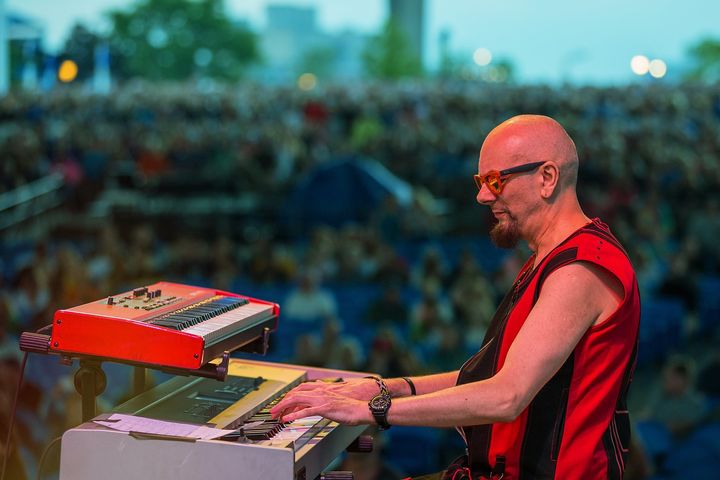
Dave Punshon Milwaukee 2014
‘Activated’ is a good and accurate description of the band Babe Ruth and the manner in which this global awakening has expressed itself through music. Looking back tells you that the merging of musical genres breaks cultural barriers that should probably never exist as a barrier but merely a mark in the sand to tell us where we are. In various ways, Babe Ruth has been the Hip Hop of Rock music for their collective love of genuinely good music and the will to progressively pursue it, regardless. This is quite possibly the way in which you create such a long lasting effect in music.
Angel Lewis
